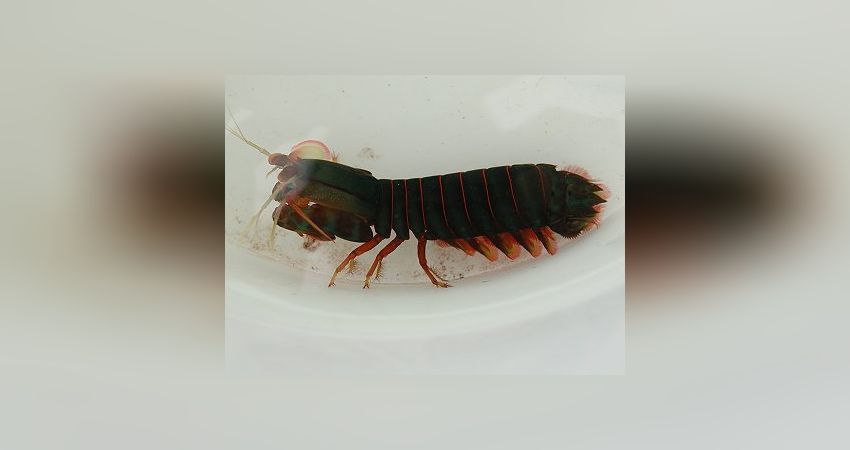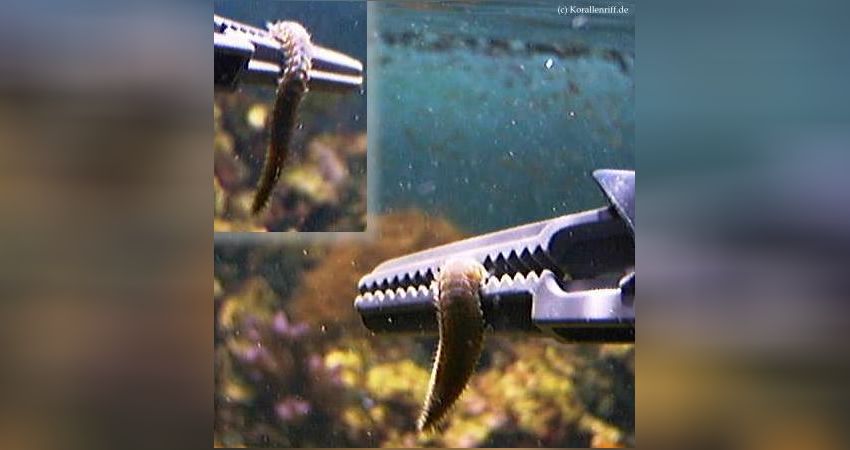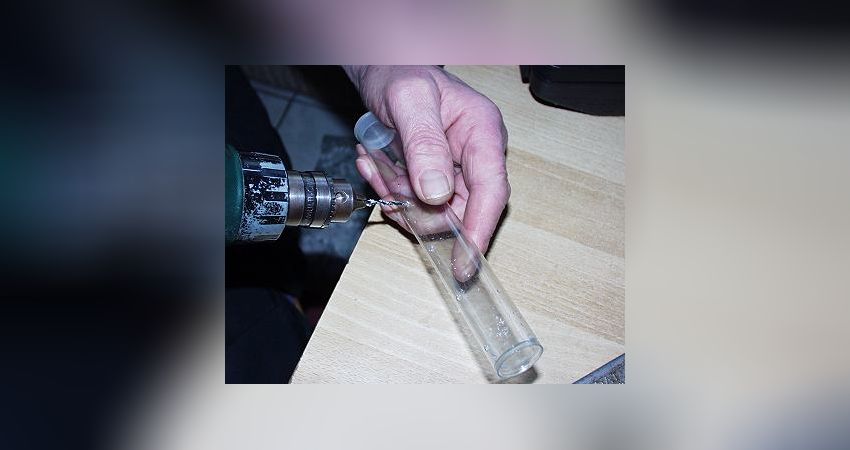37 - Pests Part 2

In part 2 on pests we go into more detail on mantis shrimps, bristle worms.
Pests Part 2: Uninvited animals
After, or even often during, the start-up phase of the aquarium, the newcomer notices that animals appear that he has not even put in. And not only do they show themselves, sometimes they also make themselves noticeable. This can be a banging or a cracking sound. In the best case it is a cracking or popping crab. Often, however, this can also be caused by crabs or a mantis shrimp. Now you probably ask yourself how the animals get into the aquarium ... But this is actually easy! By using live stones, animals also sneak in that we have not ordered. In this section we would like to give you a brief overview of what you can expect and how you should behave.
Borstenwürmer, usually a üoverdone thing...
As the living stones indeed mean real life, this can definitely happen and is also considered normal here. Often concern is also üexaggerated, with a few exceptions certainly. Bristle worms are as much a part of the aquarium as salt is to water, even if their bristly appearance means they are not particularly attractive. Also, touching them (for example when lifting a stone) leaves an unpleasant burning sensation on the skin that can last for hours.


But most are important and help keep the substrate loose. Large species, or the famous fire bristle worm, can become a real nuisance and can be a real nuisance to our animals. However, the small species found in the soil do not cause any harm. It is also important to know that bristle worms feed on carrion and usually do not harm anyone. Bristle worms are often accused of eating shellfish. They undoubtedly do, but only when the shellfish is doomed to die anyway. Have a look in your aquarium under a mussel and under some stones. You will find a lot of bristle worms under the mussel as well as under the stones. And these do not harm the mussel in the slightest! Unfortunately, there are always claims to the contrary. This is only because bristle worms are the first to recycle residues.
However, if bristle worms are a thorn in your side, you can help yourself in different ways. You can use certain animals to get rid of the bristle worms, or you can also set up so-called food traps. Animals that like to eat bristle worms are, for example, wrasses of the genus Halichoeres, but also shrimps such as Stenopus hispidus. However, we would like to deal with the well-known traps here. These can be two styrofoam bags filled with frozen food, which are best placed together with a rubber band, as bristle worms love it very much and it seems to them like substrate. Or, as shown in the following picture, a so-called homemade bristle worm trap.
For example, you can take an empty coral glue stick and put a few holes in it. The most suitable lengths have been found to be 4, 6 and 8 mm. Here, too, bristle worms like it tight and lorikeets prefer it according to their body size. Here, too, the trap should of course be stocked with tasty frozen food, for example mussel meat. Of course you should hide this trap in the substrate. There is nothing to be said against putting a little weight on the pole. Now you have laid out a box that you only have to empty the next day. You can repeat this as often as you like.
Crabs:
With the bristle worms you almost always bring in crabs. These are well camouflaged and hidden in the stones and usually survive any transport. Over time they grow up... and often you don't even see them.
They prefer to show themselves in the twilight or at night where they scurry through the tank. However, most crabs are not necessarily a threat. Many of them prefer to live on algae and growth, but will often not eat meat. By feeding in the aquarium, the crabs are usually fed as well. However, there are also observations where fish or even flower animals have become victims of crabs. If you notice something like this, you have to set up a crab trap. Often it is enough to know where the crab has its
so-called residence. This is the only way it can "smell" a crab better when it is placed near it.
We have had good success with a white beer glass. This is placed in the decoration, also filled with some frozen food (mussel meat). With a bit of luck you can find a crab on the bottom of the glass in the morning, which then no longer manages to escape the trap on the naked glass. Of course, setting a trap only makes sense when the rest of the fish are already asleep, i.e. when the lighting is switched off.
Here you will find a very interesting link to a very inexpensive crab trap that you can quickly make yourself.
Mantis shrimps:
Now we come to the probably smartest and therefore most dangerous animals that can be brought in. As with the crabs, this happens through the use of live stones. Often you don't see them, but sometimes you hear them. Whether it's a pop or a crack, that would definitely make us sit up and take notice... especially when animals disappear.

Now good advice is expensive because mantis shrimps are, as already mentioned, very clever. Often they don't even let themselves be seen. Here, too, a trap can help, or the godfather of chance. Some mantis shrimps even become quite trusting and recognise the keeper, if the remaining stock allows it. However, achieving this trust often requires targeted feeding of the animal.
We would still advise you to catch the animal from a community aquarium and keep it separately. Whether in its own tank (does not take up much space) or in the filter tank is irrelevant. But please do not do one thing... Do not kill the animal! You can succeed with the presented crab trap or with
a commercial trap, or you have to remove the stone (the housing) of the crab and then get the crab out of the stone.
In any case, we wish you good luck with the hunt, and remember it is live animals that you catch, there are enough aquarists who would like to keep something like that :-)
Frank Diehl, Robert Baur-Kruppas
How do you like this article?
Info
Author

Bookmark
Comments
Topics
Similar articles
- 01 - Sources of information
- 05 - Technical basin
- How a marine aquarium is created Part 45: The new Maxspect MJ-GF4k cross-flow pump
- How a seawater aquarium is created Part 11: the skimmer is installed
- 36 - Pests Part 1
- How a saltwater aquarium is created-Part 4: The initial water
- 08 - Water movement and filtration
- 32 - Hairy stars in the aquarium
- How a marine aquarium is created Part 28: When space in the aquarium is at a premium.
- 23 - Crustose disc anemones and soft corals:
Comments To the top
LG
ich habe letztens eine Bericht über Fangschreckenkrebse gesehen.
Da wurde erwähnt das dieser Krebs auch Aquarienscheiben Zertrümmern kann, habe so etwas noch nicht erlebt, aber er kann ja auch ganz andere sachen, dann wäre das doch garnicht mal so undenkbar oder?
Gruß
Nico
Nachdem ich das Becken stundenlang abgesucht hatte, hab ich den Fango aus seiner Höhle gucken sehen. Durch gezieltes füttern wurde er sehr zutraulich und ich konnte ihn in ein separates Becken verfrachten.
Seitdem hat mich das Fangi Virus angesteckt und ich pflege einige in separaten Aquarien. Die Tiere sind faszinierend und hoch interessant zu beobachten. Zudem sind sie recht pflegeleicht und gehen auch ohne Probleme ans Futter. Die etwas heikleren Arten (meist Späher) schleppt man sich eigentlich nie mit lebenden Steinen ein. Darum wenn ihr einen Fangi im Becken habt, entfernt ihn aus dem und pflegt ihn in einem separaten Becken (muss nicht gross sein), ihr werdet es nicht bereuen, im Gegenteil ;)
Ansonsten finden sich inzwischen auch viele Aquarianer, mich eingeschlossen, die einen Fangi mit Freuden aufnehmen. Bitte auf keinen Fall das Tier töten!!!
Ich bin dabei mir ein Meerwasser einzurichten und fand gerade die Artikel über Plagegeister sehr interessant und diese Artikel haben mich auch etwas entspannt, da ich eben schon einen Borstenwurm gesehen habe, und hoffe, dass es nicht die große Form Feuerborstenwurm ist. Werde aber das Ganze auf mich zukommen lassen.
Please register
In order to be able to write something yourself, you must register in advance.













